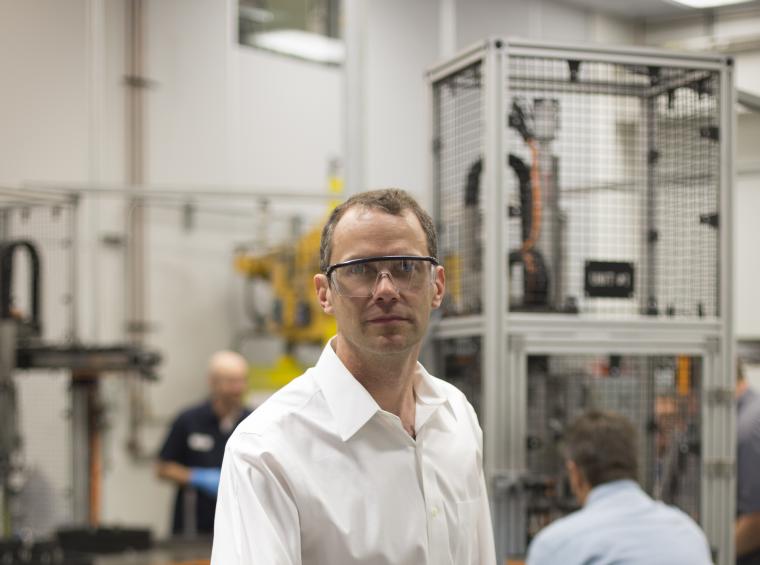Inventor Jay Whitacre '94 Earns Lemelson-MIT Science Prize
September 15, 2015
Kasey Cheydleur

Photo credit: the Lemelson-MIT program
Jay Whitacre ’94, entrepreneur, inventor, and professor at Carnegie Mellon University’s College of Engineering, has just received the $500,000 Lemelson-MIT Prize for the Aqueous Hybrid Ion battery, which has the potential to revolutionize the way sustainable energy is stored. The innovative battery uses abundant, inexpensive resources such as water, sodium, and carbon to store excess energy, enabling sustainable energy to be used for around-the-clock consumption even when neither the sun is shining nor the wind blowing. The company Whitacre founded, Aquion Energy, has commercialized the Aqueous Hybrid Ion battery for installations at locations in Australia, California, Germany, Hawaii, Malaysia, and the Philippines.
The annual Lemelson-MIT Prize honors outstanding mid-career inventors improving the world through technological invention and demonstrating a commitment to mentorship in science, technology, engineering and mathematics (STEM). Whitacre says he plans to contribute a significant amount of the prize money to develop a fellowship for graduate students to pursue innovative energy initiatives.
“We are proud to recognize Jay Whitacre as this year’s Lemelson-MIT Prize winner,” said Joshua Schuler, executive director of the Lemelson-MIT Program. “Jay is passionate about sharing his experiences with young people and is intent on inspiring them to cultivate an interest in STEM and invention. He personifies the mission of Lemelson-MIT through his commitment to mentorship, his desire to solve some of our world’s greatest problems and his ability to commercialize his technologies.”
While at Oberlin, the Westerville, Ohio, native majored in physics and says his time at Oberlin influenced and inspired the work he does today.
"I owe Oberlin a lot. It was, and is, a hotbed of creativity and has an inspiring, dynamic, free- thinking student body. Earning a degree in physics at Oberlin changed me in many ways, and a key concept I gained is that learning and knowing specific facts and figures is not nearly as powerful as being able to synthesize solutions using foundational input placed in the right context. Solving problems with this mindset has allowed me to change fields and explore unusual problems multiple times in my career. John Scofield was my primary mentor—he let me run free in his labs while researching thin film solar cells, and much of my interest and passion for energy technologies stems from those days."
Scofield, a professor of physics, says Whitacre was “the quintessential self-starter. Words like ‘you can't do that’ or ‘it can't be done’ just wouldn't dissuade him—they made him more determined to prove he could do it—whatever ‘it’ was.”
After Oberlin, Whitacre received a PhD from University of Michigan. He went on to work at the California Institute of Technology’s Jet Propulsion Laboratory, where he led research efforts to understand and improve materials for space and terrestrial use. While at Caltech, he was also first cognizant engineer in charge of designing the thermal battery-based system that powered the descent and landing phase of the Mars rover Curiosity’s mission in 2012.
Today, Whitacre is a professor of engineering and public policy and materials science and engineering at Carnegie Mellon University, a position that allows him to share ideas and results with many diverse communities, including academia, the energy startup community, and the wider Pittsburgh community. In addition, he holds the title of chief technology officer at Aquion Energy. Through his involvement at Aquion, he has worked with several programs designed to increase student accessibility to STEM fields, including the Summer Engineering Experience for Girls (SEE), the “Tour your Future” program, and the SUCCEED program, which works with STEM-inclined high school students in the Pittsburgh area.
You may also like…
Josh Nolan Named Vice President, General Counsel, and Secretary at Oberlin
Distinguished attorney brings extensive experience in higher education law.
Learning by Teaching: Oberlin Students Share Global Music with Young Learners
College and Conservatory students in PACE 103 prepare local children for an immersive community concert at Oberlin.
Nuiko Wadden ’02 Joins Oberlin Conservatory Faculty as Assistant Professor of Harp
The versatile musician brings extensive opera, orchestral, and contemporary music experience to her role


